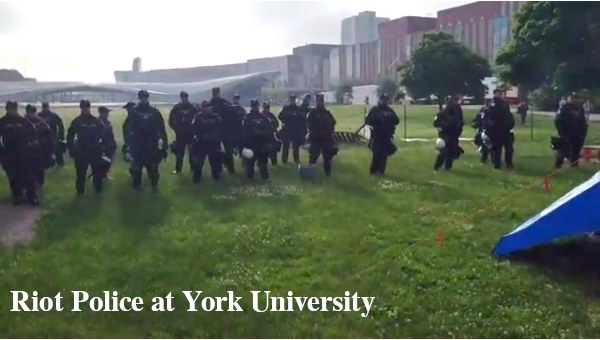Austerity U: Preparing Students for Precarious Lives
Almost everywhere you look around the world, policy-makers are introducing big changes to university systems and pondering deeper transformation. It isn’t surprising that these changes take different forms on campuses in countries as different as Canada, Britain, the United States, Chile, Greece, and India, but there are also important common themes in the change agenda globally. These include rapid increases in tuition fees, new models of university governance, new ways of teaching, a significant shift in subject matter, an attempt to depoliticize campuses, and major alterations in employment relations.

Politicians, bureaucrats and business leaders are clamoring for these changes on the basis of three key claims about colleges and universities. They argue that the post-secondary system: 1) is not preparing students for the contemporary job market; 2) costs too much in public funds; and 3) is horribly out of date, particularly in the age of information technology. The combination of technological change, high levels of unemployment or underemployment among younger people, and the recent wave of cuts to social programs and working conditions (also known as the austerity agenda) seems to present governments a compelling case for moving very quickly to transform post-secondary education.
Student Mobilization Against Austerity
Of course, this does not mean that the austerity agenda on campus is inevitable or that it should be embraced. Students have mobilized impressively against the agenda of governments and employers, ranging from mass struggles in Chile to occupations at the Cooper Union school of the arts in New York and Sussex University in Britain, to the remarkable mobilization and strike of 2012 in Quebec. These movements have expressed bold visions of the future on and off campus in slogans like “No to profit” (in Chile) and “It is a student strike, and a popular struggle” (in Quebec). They have won some important victories, such as the reversal of the planned tuition increases in Quebec.
These movements show us the best way to oppose the austerity agenda in post-secondary education, which is to develop a different strategy for transformation based on accessibility, democracy, decolonization, and a commitment to good jobs and equity-oriented employment. We can’t simply defend the university as it is. Nor can we resign ourselves to a reform agenda that will make the system much worse. We need to show that a better world is possible.
Walking the Tightrope Without a Net
If you scrape away at corporate and government criticisms of the university system in Canada, the core of the austerity agenda becomes clear. Employers and policymakers believe universities are out-of-control institutions that are doing a bad job of preparing students to walk the tightrope of life in austerity capitalism without a net.
Students graduate from university with a legitimate expectation of a somewhat better life than they might have had otherwise. Many take on debt and work grueling jobs in order to pay the high costs of school on the assumption that they’re doing what needs to be done in order to survive after graduation. But increasing numbers of graduates are facing brutal conditions: high unemployment among younger workers, the disappearance of well-paying, stable jobs, a lack of social programmes, and ever-increasing expenses for housing and other necessities.
Governments, business leaders, and their supporters in the media are blaming universities for these problems, arguing that post-secondary education is simply not preparing students for the real world. A recent column in the Globe and Mail was headlined: “Student debt crisis? No, expectations crisis.” Its author routinely accuses universities of offering irrelevant degrees and students of foolishly enrolling in irrelevant programs, depriving themselves of the skills necessary to compete on today’s job market. Yet, with the possible exception of a quite limited number of skilled trades jobs, there is simply no basis for claiming that there is an actual skills shortage among university graduates seeking employment.
The real shortage is good jobs. The real culprit is corporations and governments that have spent the last 30 years gutting the workplace, wiping out jobs with some degree of security, decent pay and benefits, and replacing them with various forms of precarious employment. It is common to hear students talk about having to work unpaid internships in order even to be considered for entry-level paid positions. They are keen and capable; it’s the opportunities for well-compensated work that are missing.
Yet from the point of view of employers and governments, the problem is not a lack of decent jobs available to young people but the hopeful attitudes of students and recent graduates. The key to preparing students for the real world they face upon graduation would be to shatter their expectations of a decent life by teaching disentitlement either openly in the curriculum (for example, through entrepreneurship education) or through the structure of the system (for example, through user pay, sharp tuition increases, and ever-expanding class sizes).
Ultimately, the goal of this transformation is a university system that, along with certain skills and knowledge, teaches students: “You are entitled to nothing. You have no right to anything you cannot afford, and you will only be able to afford things through a life of constant hustle.”
The pay wall of higher tuition fees broadcasts this message clearly. The introduction of new teaching technologies and increased use of distance education together with the mass classroom methods already in use make for a form of less-human learning, in which feelings and bodily presence are detached from information and knowledge of the subject matter. The focus on more practical entrepreneurial and commercial skills pushes an ethos of survival of the fittest and intense competition. This focus corrodes the cultivation of a sense that all people have certain rights, including access to what they need for a decent quality of life. Innovation and entrepreneurship are about creating profit for a handful of people, rather than sharpening experience in problem-solving in the service of human needs. The rapid development of Austerity U is about establishing a new normal in which individual students are forced to take on all the responsibility for coping with the harsh realities of increasingly difficult and precarious life chances.
Elite Formation
In Canada, at least, this agenda of disentitlement faces one serious impediment. A small layer of students must still be trained to rule or assist those who rule. The elite-in-training, who come mainly from very wealthy backgrounds, go to university to learn the craft of running things and extracting profits from the labour of others. So while Austerity U is largely about breaking the hopes of the many, it also requires ways to reproduce the privilege and power of the few.
In the United States and Britain, universities accomplish elite formation by segregation. The elite simply attend different institutions. The student body at Ivy League schools in the U.S. or Oxford/Cambridge in Britain is disproportionately made up of students from elite backgrounds who went to private schools. There they are trained to rule, largely through a fairly traditional liberal arts education.
In Canada, the publically funded system is less stratified. This makes it harder to maintain a traditional liberal arts curriculum for elite formation while at the same time developing a different kind of education for the mass of working-class students. This is part of the reason that “differentiation” has become a key word, and a key policy goal, in Ontario’s restructuring of post-secondary education. Structures and expectations that support a more equitable system must be replaced by structures and cultures that reproduce hierarchy.
From the start, universities were developed to do the work of elite formation, preparing the rulers to rule by enhancing their abilities at analysis, communication and calculation. The first universities were formed in Europe between the 11th and 13th centuries. There were models of higher learning in other places, but the university as it is now constituted is a development of this European model spread around the world through relations of imperialism and capitalist globalization.
Universities focussed primarily on elite formation until roughly the middle of the 20th century. Between the 1940s and 1960s the system was expanded in many places around the world as part of the growing welfare state, which introduced massive, publically-funded social programs in areas such as health care and education. On the one hand, new forms of employment associated with the expansion of state services and new layers of technical and professional workers in corporations required a new kind of preparation through extended education. On the other hand, people began to demand educational inclusion, with particularly important struggles being waged by African-Americans and women. Educational access became a widely accepted marker of social justice associated with the welfare state.
In Canada, the period of the welfare state produced a university system that, by global standards, was relatively undifferentiated. For example, a student who did well at a lower-reputation university could gain admission to graduate school at a higher-reputation institution. That simply would not happen in the United States. So to design a system that can efficiently shatter the expectations of the bulk of working-class students, it is necessary to hive off a special place of learning to build the capacities of the elite. Ontario is at this moment implementing a post-secondary education differentiation framework.
Remaking Campus Politics
Government policymakers, corporate management and university administrations face serious obstacles when trying to make their reform agenda work. One reason is that traditions of faculty self-regulation combined with a high level of unionization are an obstacle to rapid change (for better and for worse). Tenured faculty members’ resistance to change tends to be driven by a desire to protect their own freedoms and living standards, which makes it difficult to build alliances with groups in less-secure, lower-status positions. That said, many faculty members are suspicious about university restructuring and have shown some willingness to challenge recent proposals. The growing numbers of contract faculty, who are extremely overworked and underpaid, have led faculty criticism of Austerity U.
A second, and much more important obstacle, is student resistance – real and potential. Universities have, since the 1960s, accepted a relatively high level of political freedom on campus. This space of freedom was won by the mass student struggles of the 1960s and 1970s. The greatest fear of governments and administrations is that students will use their political freedom, knowledge, and collective power to fight back against restructuring.
This fear explains why the austerity agenda includes attacks on campus freedom of expression, imposing regimes of labour relations focussed on casual labour, and new managerial modes of university governance. The attacks on campus freedom of expression range from disciplinary measures against activists at Sussex University in the UK to the shut-down of Students Against Israeli Apartheid at York University, to the mass arrests of protesters during the Quebec student strike of 2012, to coercive student conduct and use-of-space policies that deny students the ability to assemble freely on campus. These attacks go along with a range of changes in employment relations and university governance.
Of course, at some level Austerity U is about dramatically shutting down campus politics altogether as the proportion of university revenue coming from government grants shrinks – making tuition fees, corporate dollars and other sources of revenue ever more important – and universities become increasingly like corporations. The logic of decision-making will then be primarily commercial, whether that means casting students as customers or assessing the value of university research in terms of its contribution to corporate profitability. This logic is already deep-set into the planning processes of many universities that are using cost-benefit analysis as the key tool in setting campus priorities.
The key to fighting the austerity agenda for the universities will be our ability to remake campus politics from below, to challenge the restructuring from above. This cannot be done simply by defending the way things were in some imagined golden age of the university. Rather, it will be done by building campus coalitions for democratic, accessible and decolonized education built around good jobs and equity-oriented employment practices.
Quebec students during the 2012 mobilization raised important visions of a more democratic and accessible education, with very different models of governance and learning. The racist and colonialist perspectives that are hard-wired even into the definitions of knowledge that apply on campuses need to be challenged and remade. The austerity agenda will not be shaken by a defence of the good old days of the university, but by a powerful mobilization from below with the audacity to develop a real sense of where collective learning and solidarity can lead. •





